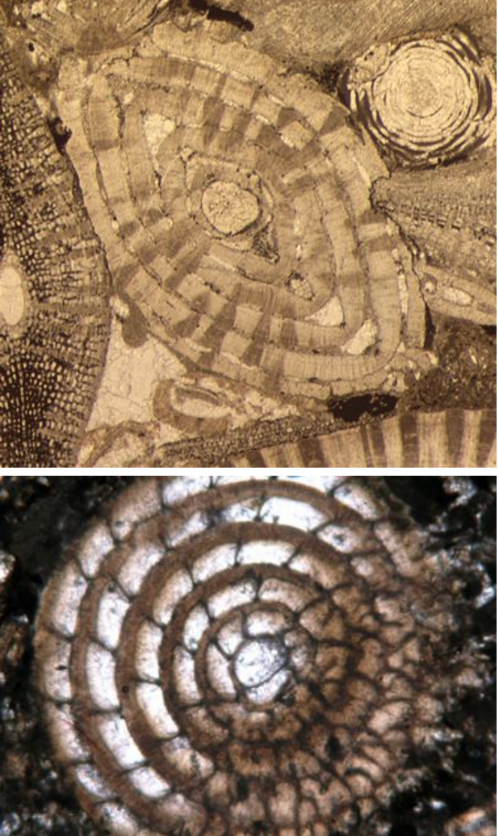Skeletal and Nonskeletal
1/56
There's no tags or description
Looks like no tags are added yet.
Name | Mastery | Learn | Test | Matching | Spaced |
|---|
No study sessions yet.
57 Terms
Ooids
spherical grains composed of thin concentric layers of precipitated aragonite. Develops in shallow agitated warm water.
Biochemical formation of ooids
bacterial activity within the organic matter creates a microenvironment conducive to carbonate precipitation
inorganic formation of ooids
shallow tropical seas saturated with CaCO3 together with water agitation, CO2 degassing and elevated temperature might be sufficient to bring about carbonate precipitation on nuclei
Peloids
fecal matter excreted by benthic organisms. Composed of packed lime-mud
intraclasts
Composed of semi-lithified lime mud
Aggregates
peloids, ooids, intraclasts, etc. cemented together
skeletal grains or bioclasts are…
whole fragmented parts of carbonate producing organisms
What affects the distribution and development of carbonate secreting organisms
depth
temperature
salinity
substrate
turbulence
Mollusks
these refer to bivalves, gastropods, and cephalopods. Present in marine, brackish, and freshwater.
what is a rudist
coral-like bivalves formed reefs in cretaceous
describe the structure of mollusk layers
prismatic layer of aragonite prisms and nacreous layer consisting of sheets of aragonite tablets.
how are bioclasts categorized based on the organism’s life habit
Infaunal, epifaunal, agile, nektonic, planktonic
What is infaunal
organisms that live within the sediment ex. bivalves (clams), worms, etc.
what is epifaunal
organisms that live on the surface of the seafloor (oysters, brachiopods, corals, etc.)
what is agile
organisms that are mobile and can move actively across the seafloor
what is necktonic
organisms that swim actively
what is planktonic
organisms that float or drift with the ocean current
characteristics of gastropods
present in shallow marine and hypersaline backish waters
more are benthic and agile
majority have shells of aragonite with similar internal microstructures to bivalves
What are nautiloids and ammonoids
a type of cephalopod that is common in limestones of the Paleozoic and Mesozoic
What are Belemnites
A type of cephalopod in the mesozoic made of calcite with a strong radial-fibrous fabric in cross-section
What is the life habit of cephalopods?
marine, dominantly necktonic or nektoplanktonic
Where do cephalopods occur?
pelagic, relatively deep water deposits
Where are brachiopods common?
common in Paleozoic and Mesozoic limestone of shallow-marine origin
What is the structure of Brachiopods
Composed of low-Mg calcite
Commonly very thin, outer layer of calcite fibers oriented normal to the shell surface with a thicker inner layer of oblique fibers
what are the different types of corals
hermatypic, ahermatypic, rugose, and tabulate
hermatypic corals
contain symbiotic dinoflagellate algae in their polyps
Ahermatypic corals
w/o algae, forms in deeper environments and can tolerate colder waters. Locally form build-ups and barriers
Rugose and tabulate corals
corals that are important in silurian and devonian reefs
Scleractinian corals
present in many triassic reefs, composition: aragonitic
what are echinoderms
Wholly marine, includes echinoids and crinoids. Their skeletons are calcitic.
where do echinoids and crinoids occur?
echinoids inhabit reef environments while crinoids are restricted to deeper waters
What type of organisms are bryozoans
Bryozoans are colonial organisms. Presently, they are only locally significant as suppliers of carbonate sediment.
During which geological era were bryozoans major contributors to reef and limestone formation?
Paleozoic
What are the mineral compositions of modern bryozoan skeletons?
Aragonite, Calcite (High-Mg calcite), a mixture of both
Describe the fenestrate form of Bryozoans
commonly seen in Paleozoic limestones. Skeleton consist of foliaceous calcite with round holes filled with sparite.
what type of environment do foraminifera primarily inhabit
planktonic: float in water, dominate some pelagic limestones
benthic: warm shallow seas. Live on seafloor sediments
what minerals make up foraminifera tests
mostly low or high Mg calcite, rarely aragonite
what is the shape of foraminifera tests
circular to subcircular with chambers

How does the test wall structure differ between thin-walled and thick-walled foraminifera?
Thin-walled species: Microgranular texture.
Thick-walled species (e.g., rotaliids, nummulites, orbitolinids): Fibrous texture.
what is a spicule (sponges)
small needle like structure that forms part of the sponge’s skeleton. Made of silica or calcite and occur in sediments from Cambrian.
What are Stromatoporoids
marine, spherical to laminar shape, major reef organism in the Silurian and Devonian.
What are Ostracods?
Type of small arthropods, 1mm length, with bivalved shells, found in marine, brackish, and freshwater environments, typically at shallow depths.
Rhodophyta (Red algae)
Skeletons of cryptocrystalline calcite precipitated within and between cell walls. Encrustations may be massive and rounded, or delicately branched.
what are the three types of Green Algae
Codiaceae, Dasycladaceae, and Characeae
Describe Dasyclad Algae
occurs in marine, shallow, and lagoonal areas of the tropics. Occur due to incomplete calcification where aragonitic crust precipitate around the stem and branches of the plant.
What are the two common genera of Codiacean Algae
Halimeda and Penicillus
Halimeda
a segmented plant which
disintegrates into sand sized particles.
Penicillus
algal consisting of a bundle of filaments coated in needles of aragonite. Disintegrates into find grained carbonate sediment.
What are coccolithophorids
planktonic algae with low-Mg calcite skeletons. From Jurassic to recent
what is micrite
consists of mirocrystalline calcite or aragonite. In modern time it is dervied from disaggregation of calcareous green algae.
Possible sources of micrite or lime mud
inorganic precipitation
Bioerosion
mechanical breakdown of skeletal grains
Biochemical precipitation through microbial photosynthesis
what is sparry calcite
large crystals of Low-Mg calcite that form cement in limestones. Commonly form from recrystallization.
Carbonate grains can be divided into (___-chem)
allochems and orthochems
allochems are…
transported grains
orthochems
deposited in place
differentiation micrite, sparite, and microspar
micrite: <4mm lime mud, analogous to matrix in siliciclastics
spar: larger, clean interlocking carbonate crystals
microspar: 4-20 microns